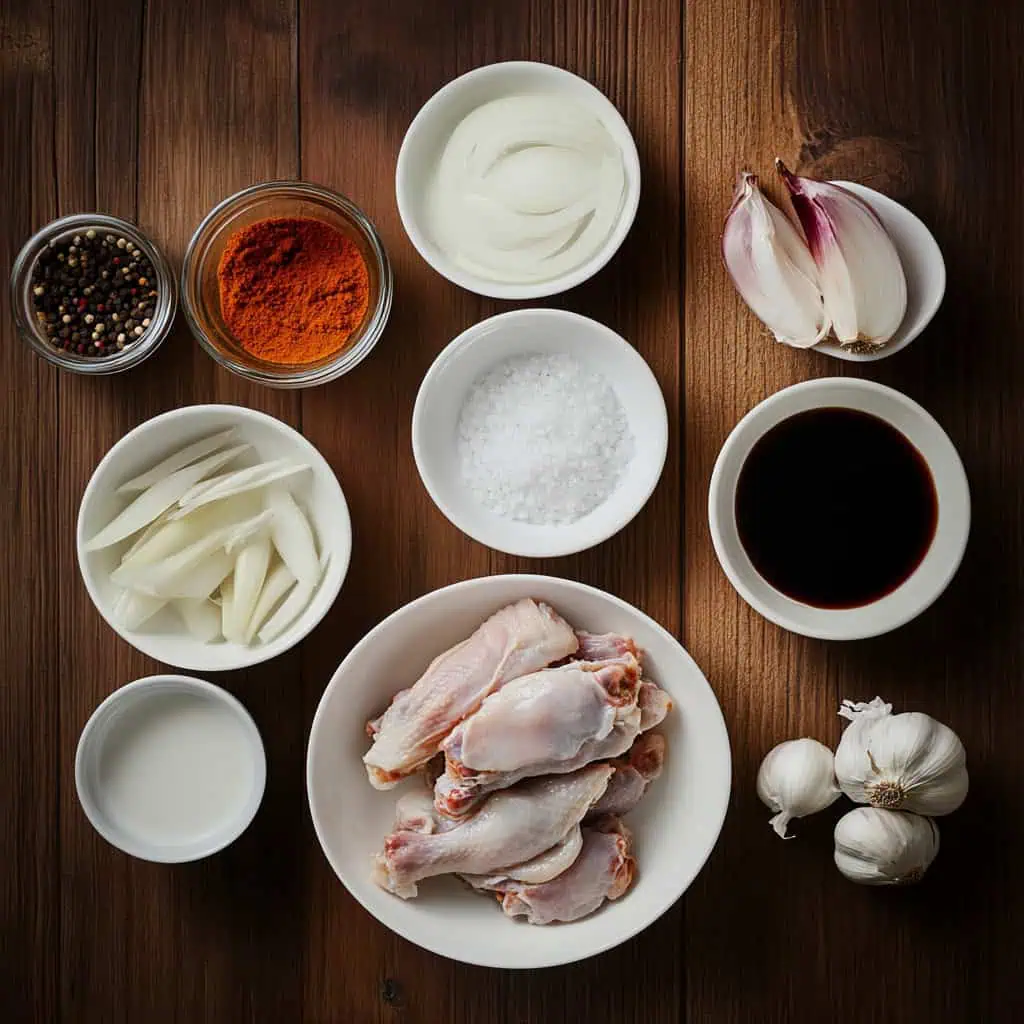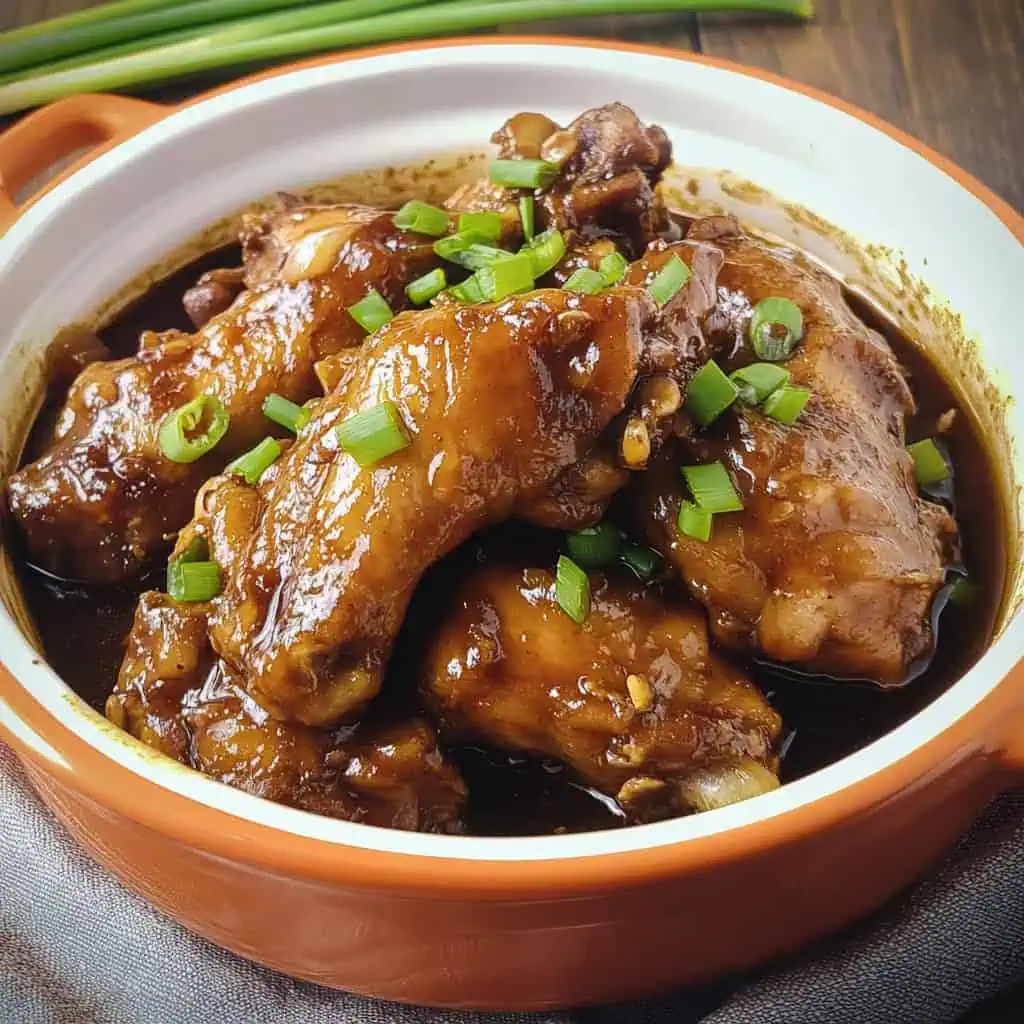You know how it goes - when you grow up Filipino, adobo isn't just food, it's part of who you are. I've lost count of how many times I've made our family's classic adobo recipe, all garlicky and swimming in that perfect soy sauce-vinegar combo.
But one day, while rummaging through my Lola's old recipes, I thought, "Why not shake things up a bit?" That's when I stumbled onto this tamarind twist. Instead of the usual vinegar, I swapped in sampalok, and it was a total game-changer!
The sauce came out rich and complex, with this amazing tang. Honestly, I love it even more than the original (sorry, Lola!). If you're an adobo lover like me who's ready to try something new but still craves that comforting adobo vibe, this recipe is absolutely for you.
Jump to:

Why You'll Love This Recipe
- Perfect Balance: The tamarind provides a naturally complex sourness (asim) that's more rounded than vinegar
- One-Pan Wonder: Everything cooks in a single pan, minimizing cleanup
- Make-Ahead Friendly: Tastes even better the next day as flavors develop
- Budget-Friendly: Uses affordable chicken parts and pantry staples
- Freezer-Friendly: Perfect for meal prep and batch cooking
Ingredients
Each component in this recipe serves a purpose in creating the perfect tamarind adobo. Chicken wings offer tender meat that absorbs flavor beautifully while creating a rich sauce. Garlic and onions form the aromatic foundation essential to Filipino cooking.
Tamarind provides a complex sourness that's more nuanced than vinegar, while soy sauce adds umami depth and beautiful color. Together, these simple ingredients create a perfect harmony of flavors that's both authentically Filipino and uniquely delicious.

- 3 pounds chicken wings, cut into drummettes and wingettes
- 1 large onion, thinly sliced
- 6 cloves garlic, minced
- 1.4 ounces tamarind powder or 1 cup fresh tamarind pulp
- ¼ cup soy sauce
- 1 cup water
- 1 tablespoon cooking oil
- Salt and pepper to taste
For Garnish:
- Green onions, chopped
- Crispy fried garlic
Equipment
- Large heavy-bottomed pan or kawali: For even heat distribution and proper browning of the chicken. A Dutch oven works well too.
- Sharp knife and cutting board: For preparing ingredients safely and efficiently.
- Measuring cups and spoons: For precise measurements to ensure balanced flavors.
- Wooden spoon or silicone spatula: For stirring without scratching your cookware.
- Fine-mesh strainer: For extracting fresh tamarind pulp if using instead of powder.
- Instant-read thermometer: For checking that chicken reaches safe internal temperature of 165°F.
- Tongs: For easily flipping chicken pieces during browning.

How To Make
- Prepare the chicken: Pat the chicken wings dry with paper towels. This ensures better browning.
- Sauté aromatics: Set your stove to medium heat and warm the oil in a large, heavy-bottomed pan. Once hot, add thinly sliced onions and cook until soft and translucent (3-4 minutes). Add minced garlic and cook for another 30 seconds until fragrant.
- Brown the chicken: Add chicken wings to the pan and increase heat to medium-high. Cook for 8-10 minutes, turning occasionally until all sides are nicely browned with a beautiful golden color.
- Add flavoring agents: Sprinkle tamarind powder over the wings and stir well to coat each piece evenly. Pour in water and soy sauce, then stir thoroughly.
- Simmer: When liquid begins to bubble, lower heat to medium-low, cover the pan, and simmer gently for 25-30 minutes, stirring occasionally. During this time, the sauce will gradually thicken and the chicken will become tender.
- Check for doneness: Chicken is done when easily pierced with a fork and internal temperature reaches 165°F.
- Adjust seasoning: When sauce has thickened to your liking and chicken is cooked through, taste and add salt and pepper as needed. If too sour, add a small pinch of brown sugar to balance flavors.
- Rest and serve: Turn off heat and let adobo rest for 5 minutes to allow chicken to absorb more flavor. Transfer to a serving bowl, scatter chopped green onions and crispy garlic on top, and serve hot with steaming rice.

Tips from Lola's Kitchen
- Overnight marination: For deeper flavor, marinate the chicken in soy sauce overnight in the refrigerator before cooking.
- Patient browning: Don't rush the browning process—it builds essential flavor foundations for the dish.
- Rest before serving: Allow the dish to rest 10-15 minutes before serving to let flavors settle and develop.
- Embrace the tutong: Those slightly caramelized bits at the bottom of the pan are flavor gold when mixed with rice.
- Day-after magic: Like many stewed dishes, adobo often tastes even better the next day after flavors have melded overnight.
- Bone-in benefits: Using bone-in chicken parts adds richness to the sauce as the marrow infuses into the broth during simmering.
Substitutions
- Chicken parts: Instead of wings, use chicken thighs, drumsticks, or a whole chicken cut into serving pieces. Cooking time may vary.
- Tamarind: If tamarind is unavailable, substitute with 3 tablespoons of apple cider vinegar plus 1 tablespoon brown sugar.
- Soy sauce: Coconut aminos or liquid aminos work well for a gluten-free alternative with slightly different flavor notes.
- Fresh garlic: Substitute with garlic powder in a pinch (1 teaspoon equals approximately 2 fresh cloves).
- Protein options: Try with pork belly, beef chunks, or firm tofu for vegetarian version (adjust cooking times accordingly).
Troubleshooting
- Too sour: Add a pinch of brown sugar or a teaspoon of honey to balance acidity.
- Too salty: Add quartered potatoes to absorb excess salt, or dilute with a small amount of water and simmer longer.
- Too thin: Simmer uncovered for 5-10 additional minutes to reduce sauce. For quicker thickening, add 1 teaspoon cornstarch mixed with 1 tablespoon water.
- Too thick: Add water gradually, a tablespoon at a time, while stirring until desired consistency is reached.
- Bland flavor: Try adding a bay leaf during simmering or boost umami with a splash more soy sauce.
- Chicken not tender: Continue simmering in 10-minute increments until meat easily pulls away from the bone.
Storage & Reheating
- Refrigerator: Store in an airtight container for 3-4 days.
- Freezer: Freeze for up to 3 months in freezer-safe containers (exclude garnishes).
- Reheating on stovetop: Place in a pan over medium heat with a splash of water to prevent drying out. Heat until internal temperature reaches 165°F.
- Reheating in microwave: Heat in a microwave-safe container for 2-3 minutes, stirring halfway through.
- Flavor enhancement: Add a splash of soy sauce or sprinkle of tamarind powder when reheating to refresh flavors.

FAQ
Can I use bone-in chicken thighs instead of wings?
Absolutely! Adjust cooking time to 35-40 minutes for thighs, as they're larger cuts.
Why isn't my sauce thickening?
Try simmering uncovered to allow for evaporation, or add a cornstarch slurry (1 teaspoon cornstarch mixed with 1 tablespoon water).
Can I make this in a slow cooker?
Yes! Brown the chicken and aromatics first, then transfer to a slow cooker with remaining ingredients. Cook on low for 6-7 hours or high for 3-4 hours.
Is there a way to make this dish less oily?
After cooking, let the dish cool slightly, then refrigerate for 30 minutes. The fat will solidify on top and can be easily removed before reheating.
Can I add vegetables to make it a complete meal?
Certainly! Carrots, potatoes, and bell peppers work wonderfully. Add firmer vegetables during the last 20 minutes of cooking, and quick-cooking vegetables like bok choy in the final 5 minutes.
How can I tell if my tamarind is too old to use?
Fresh tamarind pulp should be dark brown, somewhat sticky, and have a pleasant sour smell. If it's extremely hard, has an off smell, or shows signs of mold, it's best to discard it.
What's the best rice to serve with this dish?
Jasmine rice is traditional, but any medium to long-grain white rice works beautifully to soak up the flavorful sauce.
Can I double the recipe for a larger crowd?
Yes, simply double all ingredients and use a larger pot. You may need to increase cooking time by 5-10 minutes.
Related
Looking for other recipes like this? Try these:

Tamarind Chicken Adobo (Adobong Manok sa Sampalok)
Equipment
- Large heavy-bottomed pan or kawali (Filipino wok) For even heat distribution and proper browning
- Sharp knife and cutting board For preparing ingredients
- Measuring cups and spoons For precise measurements
- Wooden spoon or spatula For stirring without scratching the pan
- Fine-mesh strainer For extracting fresh tamarind pulp if using
- Instant-read thermometer For checking meat doneness
Ingredients
For the Main Dish:
- 3 pounds chicken wings cut into drummettes and wingettes (pwedeng palitan ng ibang parte ng manok)
- 1 large onion thinly sliced (sibuyas)
- 6 cloves garlic minced (bawang)
- 1.4 ounces tamarind powder or 1 cup fresh tamarind pulp
- ¼ cup soy sauce toyo
- 1 cup water tubig
- 1 tablespoon cooking oil mantika
- Salt asin at paminta to taste
For Garnish:
- Green onions dahon ng sibuyas, chopped
- Crispy fried garlic pritong bawang
Instructions
- Begin by patting the chicken wings dry with paper towels and gathering all your ingredients. Set your stove to medium heat and warm the oil in a large, heavy-bottomed pan. Once the oil is hot, add your thinly sliced onions and cook them until they become soft and translucent, about 3-4 minutes. Add the minced garlic and cook for another 30 seconds until you can smell its wonderful aroma.
- Now add your chicken wings to the pan and increase the heat to medium-high. Cook the wings for about 8-10 minutes, turning them occasionally until they're nicely browned on all sides. You'll know they're properly browned when the skin turns a beautiful golden color.
- Once your chicken is browned, sprinkle the tamarind powder over the wings and stir well to coat each piece evenly. Pour in the water and soy sauce, then give everything a good stir. When the liquid starts to bubble, lower the heat to medium-low, cover the pan, and let everything simmer gently.
- Let the chicken cook for about 25-30 minutes, stirring occasionally. During this time, the sauce will gradually thicken and the chicken will become tender. You can tell the chicken is done when you can easily pierce it with a fork and the internal temperature reaches 165°F.
- When the sauce has thickened to your liking and the chicken is cooked through, taste and add salt and pepper as needed. If you find it too sour, you can add a small pinch of brown sugar to balance the flavors.
- Turn off the heat and let the adobo rest for 5 minutes. This short rest allows the chicken to soak up more flavor. Transfer everything to a serving bowl, scatter chopped green onions and crispy garlic on top if you like, and serve hot with steaming rice. The sauce should be perfect for drizzling over your rice.
- Remember, like any good adobo, this tastes even better the next day after the flavors have had time to develop further. Any leftovers can be kept in the refrigerator and reheated gently on the stovetop.
Tips from Lola's Kitchen
- Marinate chicken overnight in soy sauce for deeper flavor
- Don't rush the browning process - it builds essential flavor
- Let dish rest 10 minutes before serving to allow flavors to settle
- Save burned bits (tutong) - they're flavorful when mixed with rice
Nutrition
The Story Behind Tamarind Chicken Adobo
Growing up in a Filipino household, adobo was more than just our national dish - it was a testament to our resourcefulness and creativity in the kitchen. While the classic adobo, with its vinegar-soy sauce base, has been gracing Filipino tables for centuries, this tamarind version tells a fascinating story of regional innovation and family traditions passed down through generations.
In the southern regions of the Philippines, particularly in areas where tamarind trees flourish abundantly, creative home cooks began experimenting with sampalok (tamarind) as a souring agent. This wasn't just about using what was locally available; it was about discovering new depths of flavor that could transform an already beloved dish into something extraordinarily special.
My first encounter with Adobong Manok sa Sampalok came through my grandmother's weathered cookbook, its pages stained with sauce splatters and handwritten notes in the margins. The recipe stood out because it challenged everything I knew about traditional adobo. Instead of the sharp, clean acidity of vinegar, tamarind offered a more complex sourness - one that brought subtle sweet notes and a fruity undertone that perfectly complemented the rich umami of soy sauce.
What makes this version truly special is how the tamarind works its magic during the cooking process. As the chicken slowly simmers, the tamarind's tartness mellows and melds with the other ingredients, creating a sauce that's simultaneously bright and deep, tangy and savory. The result is a dish that honors our adobo heritage while bringing something new to the table - quite literally!
Today, this tamarind chicken adobo has found its place in modern Filipino cuisine, beloved by both traditionalists and food innovators alike. It's a perfect example of how our cuisine continues to evolve while staying true to its roots, proving that sometimes the most delicious discoveries come from daring to think differently about the dishes we know by heart.
Whether you're a Filipino food enthusiast looking to expand your adobo repertoire or someone just discovering the wonders of our cuisine, this tamarind version offers a delicious glimpse into the ever-evolving story of Filipino cooking. After all, every great dish has a story, and this one speaks of heritage, innovation, and the joy of discovering new flavors in familiar places.










Comments
No Comments